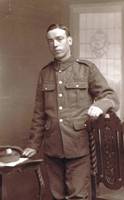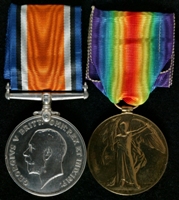
Photograph of Albert in Tameside Local Studies and Archives Centre. Reference: Acc.3987

(L to R) British War Medal; Allied Victory Medal
Albert was born in around April 1894 in Hulme, Manchester. His mother's name was Elizabeth and he had at least two older siblings; James and Mary Elizabeth. They were members of the Church of England. Albert's father had died by 1911, and the family lived at 40 Silk Street in Hulme. He was working as an errand lad at a printer's.
When the First World War broke out in August 1914 Albert was living at 17 White Street in Hulme with Elizabeth. He was not married. He was working as a Mantle Packer; a mantle is a component of gas lamps.
Albert enlisted on the 10th December 1915. Conscription would be introduced at the end of the year so he may have wanted to volunteer, and choose the unit he served in, before this happened. He was accepted into the 8th Battalion of the Manchester Regiment on the 29th January 1916 and given the service number 5258.
When he enlisted Albert was 5 feet 5 1/2 inches tall and weighed 119 pounds. He had a 'sallow' complexion. He had brown eyes and 'dark' hair.
The 8th Battalion had been overseas since 1914, so new recruits such as Albert were assigned to the second 8th Battalion (2/8th). This unit trained in the UK until the 13th March 1917 when it was sent to France. Shortly afterwards all the soldiers serving in units of the Territorial Force were given new service numbers. Alberts' was 301845.
We don't know much about Albert's service in France. It is likely he fought with the 2/8th Battalion during the Battle of Passchendaele between July and November 1917. He appears to have stayed with the 2/8th Battalion until it was disbanded. This happened because of a reorganisation of the Army that aimed to have more soldiers in fewer battalions, rather than fewer soldiers in more battalions. It took place on the 13th February 1918 and Joseph was sent to the 2/5th Battalion of the Manchester Regiment.
The 2/5th was reduced to a small number of soldiers; known as a cadre, in April. Albert was no longer needed so he was sent to Number 1 Overflow Camp in the British base at Etaples. On the 15th May he moved to 'H' Infantry Base Depot at the same camp to wait to be sent to a unit that needed men. Albert was able to go on leave to the UK between the 1st and the 18th June 1918.
When he returned to Etaples Albert was assigned to the 2nd Battalion of the East Lancashire Regiment. This meant Albert was given a new service number: 235681. He joined his new unit on the 21st June 1918.
We don't know what Albert did during the rest of the war. The 2nd Battalion ended the war in the Artois region of France. Albert was sent back to the UK on the 22nd March 1919. He returned to his home at 17 White Street, although he was still a member of the Class Z Reserve, so if fighting had broken out again he could have been called back to the Army. It never did so the Class Z Reserve was disbanded in March 1920.
The rest of Albert's life remains a mystery.




